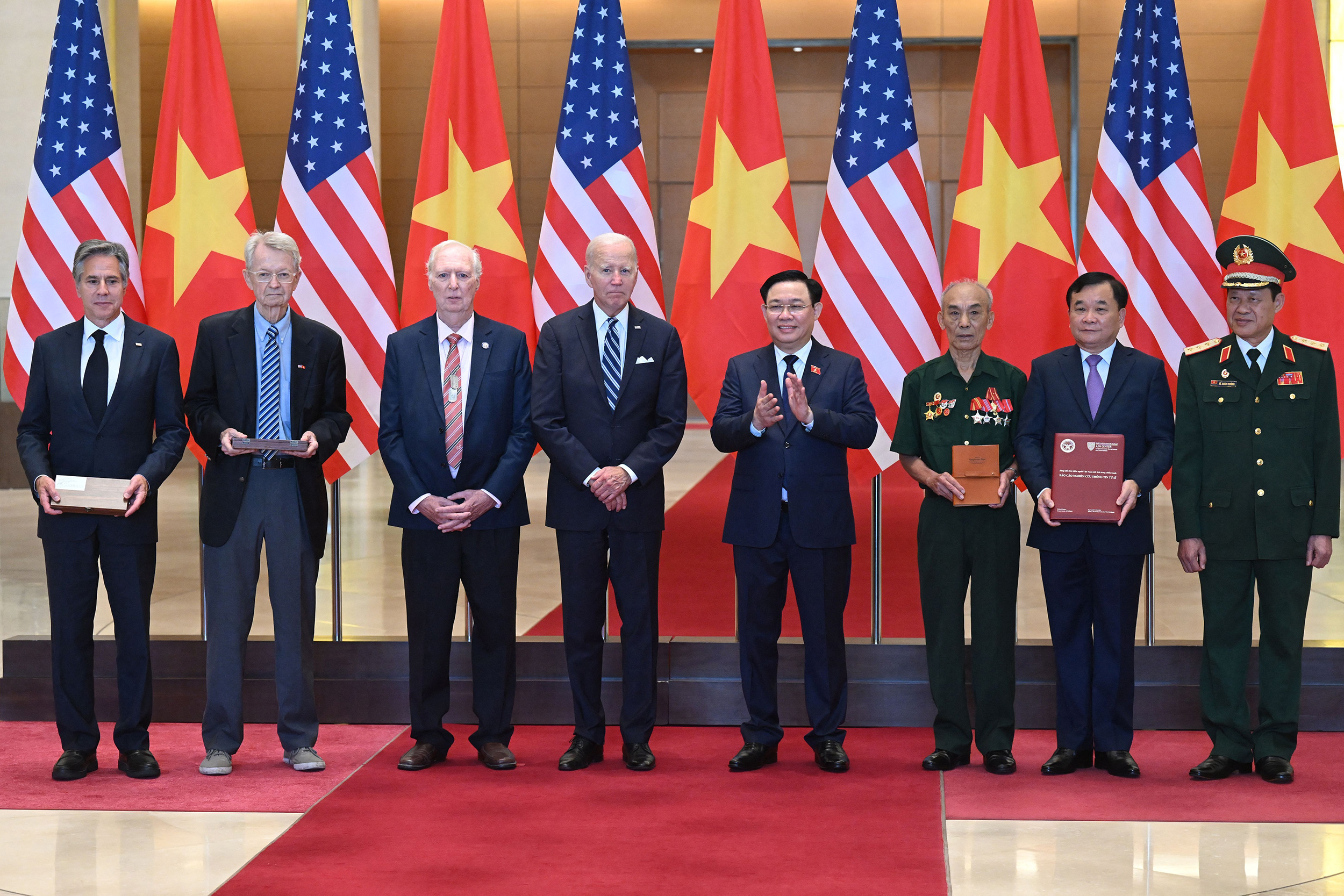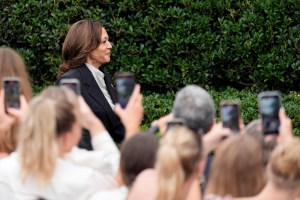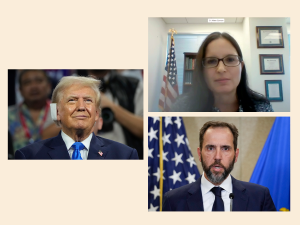
A U.S. delegation handed over Kennedy School research on the Vietnam War to officials in Hanoi during President Biden’s recent visit.
Getty Images
Documenting unseen legacies of Vietnam War
Biden helps deliver Kennedy School research documenting possible sites of Vietnamese soldiers’ remains during historic visit to Hanoi
During his historic visit to Hanoi earlier this month, President Biden helped deliver a trove of research uncovered by a team of Harvard Kennedy School historians that documents the possible fate of hundreds of Vietnamese soldiers who went missing in action during the Vietnam War.
The records, handed over by Secretary of State Antony Blinken and two American veterans of the Vietnam War in a ceremony at the National Assembly, were the culmination of months of careful research in wartime archives by a team of historians with the Rajawali Institute’s Unseen Legacies project at the Kennedy School.
Led by Tony Saich and Hai Nguyen, a Vietnam War historian, the Unseen Legacies team spent months combing through battlefield documents captured by U.S. and allied forces in Vietnam, records from the People’s Army of Vietnam, and interviews with veterans and military experts.
“As an institution, we’ve had the honor of helping to nurture the U.S.-Vietnam relationship over decades,” said Saich, director of the Rajawali Foundation Institute for Asia. “Our work speaks to both the dark pasts of the war and the bright future that lies ahead as partners in the region.”
During the war, millions of pages of captured North Vietnamese and Viet Cong documents were analyzed for their potential intelligence value. Only a fraction of this cache was ever translated into English. After their intelligence value faded, these records were preserved in a haphazard manner — making it a challenge for historians and others to provide a more comprehensive analysis of this collection of remarkable firsthand accounts and other evidence from the front lines.
But the documents held in the U.S. — as well as similar ones in Vietnam — eventually became the focus of military officials and civilian leaders working to identify possible locations of service members’ remains. “We knew that the archives contained information that could potentially lead us to burial sites providing identifying information of those still missing,” Nguyen said.
“There are still an estimated 200,000 soldiers still unaccounted for. … Every burial place that we help identify or personal artifact that we can return helps a family find some degree of closure.”
Hai Nguyen, historian
As the U.S. and Vietnam began the process of political rapprochement in the 1990s, identifying and recovering the remains of war dead from both sides became an early area of cooperation.
“For Vietnam, much as in the U.S., locating the remains of those who died in combat retains extraordinary political potency,” said Saich, who traveled to Vietnam with Nguyen in the spring to help repatriate records and other personal effects identified through the Unseen Legacy project team’s archival searches. “It’s quite remarkable how the two countries have used this emotionally charged issue to build trust on both sides over the years.”
Officials on both sides began to scour their wartime archives for information that could lead investigators to the remains of missing service members. With funding from the U.S. Department of Defense, Nguyen began assembling a team of researchers in the U.S. and Vietnam to launch a systematic review of the captured documents and help uncover information on Vietnamese combatants still listed as missing in action.
“It’s quite remarkable how the two countries have used this emotionally charged issue to build trust on both sides over the years.”
Tony Saich, director of the Rajawali Foundation Institute for Asia
More like this
To help prepare for Biden’s visit, Nguyen and his team worked to provide Pentagon officials with detailed findings on the location of possible Vietnamese war dead, which the president’s delegation could present to their Vietnamese counterparts as part of the Department of Defense’s longstanding efforts to identify the remains of combatants from both sides of the conflict.
After months of sifting through countless captured tactical plans, battle reports, unit rosters, death notices, journals, even personal effects, the Unseen Legacies researchers prepared a report detailing the possible locations of 563 individual Vietnamese war dead. During their research, they also came across personal artifacts such as letters and diaries from Vietnamese soldiers, which will be returned to surviving family members.
For Nguyen and his team with the Unseen Legacies project, Biden’s visit helped shine a light on the unheralded and often tedious work of researching these decades-old archives.
“It was incredibly gratifying to see the reaction to what we’re doing, but there are still an estimated 200,000 soldiers still unaccounted for — along with 300,000 unidentified remains waiting to be unidentified in Vietnam,” Nguyen said. “Nearly half a century after the fighting stopped, countless families still have no idea what happened to their loved ones. Every burial place that we help identify or personal artifact that we can return helps a family find some degree of closure.”
Saich agreed. “I’ve spent much of my career nosing about archives, and it’s hard to think of a more impactful project than this,” he said. “The work, in its own small way, helps draw two former foes closer together — and heal some of the remaining wounds of the war.”





